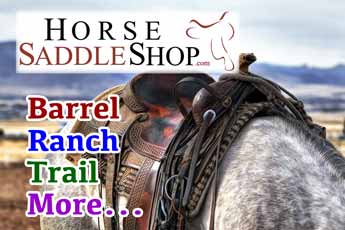Ranch Rodeo Photos - Page 2 of 3
A ranch rodeo is a rodeo where contestants compete as teams from ranches, not as individuals.
The events at a ranch rodeo vary, but commonly include sorting, doctoring, wild cow milking, ranch bronc riding, branding, mugging, and/or others.
A description of ranch rodeo events can be found at the bottom of this page beneath the pictures.
All photos are copyrighted © and property of CowboyWay.com
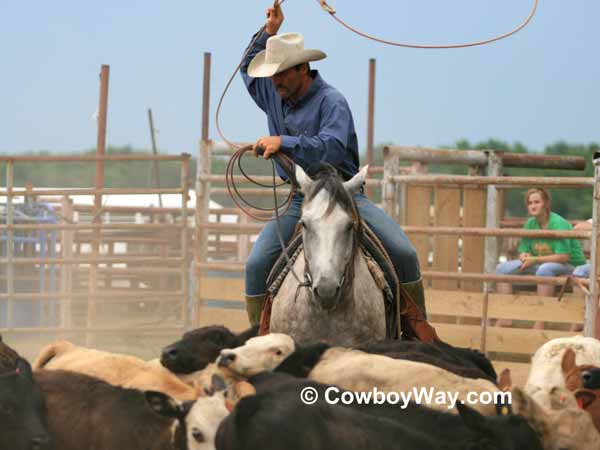
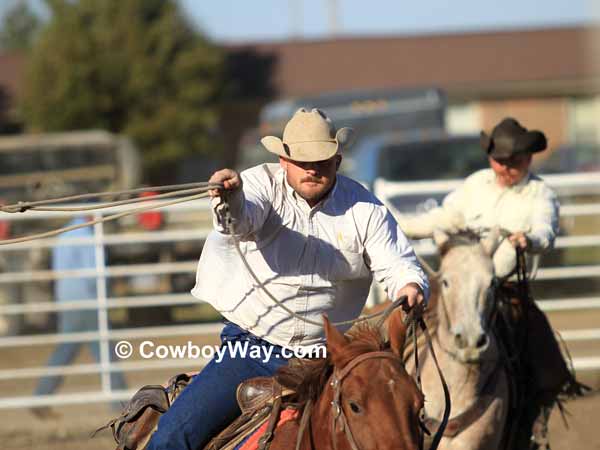
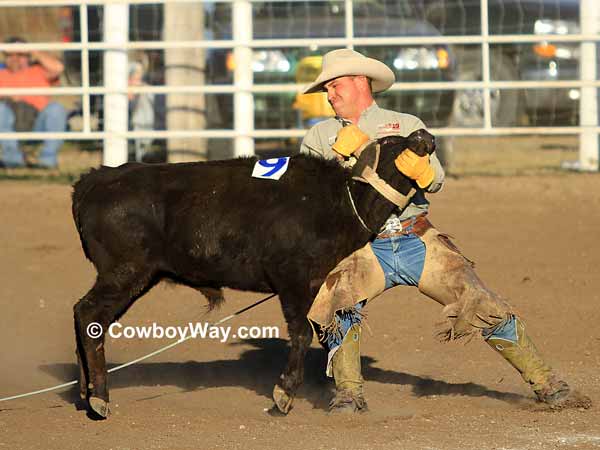
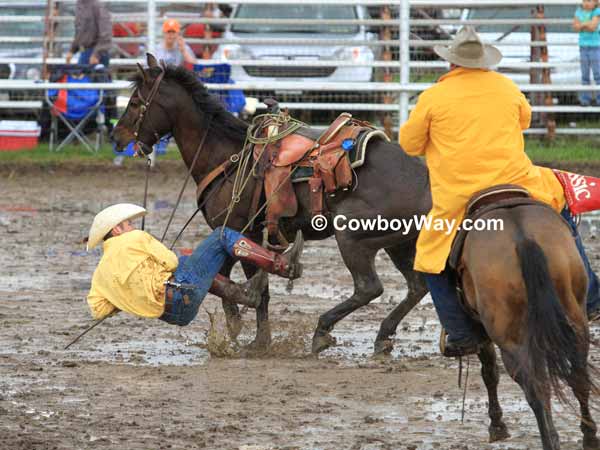
Advertisement - Photos continue below.
Below: This photo was taken at the Working
Ranch Cowboys Association (WRCA) Finals in Amarillo, Texas. The horse being
ridden by Brad Good of Swenson Land and Cattle began to buck during the
stray gathering event.
Brad stayed with the horse and even managed to guide
him where he needed to be in order to get off and help his partner already
on the ground. Then he got off, cowboy style. You can see more photos of this here:
WRCA Finals, Stray Gathering.
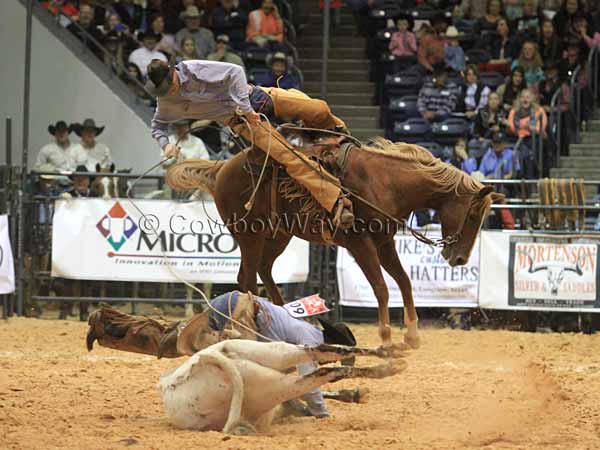
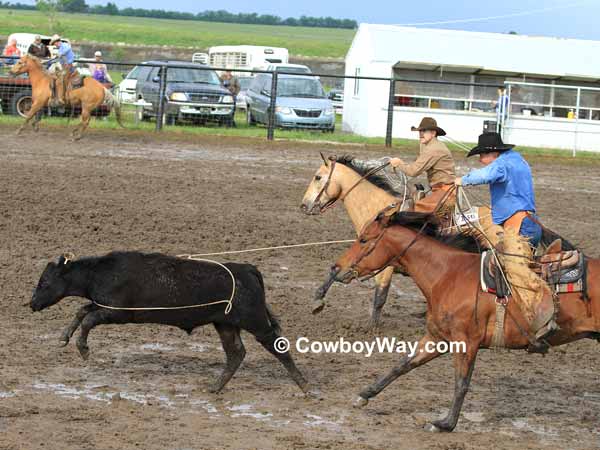
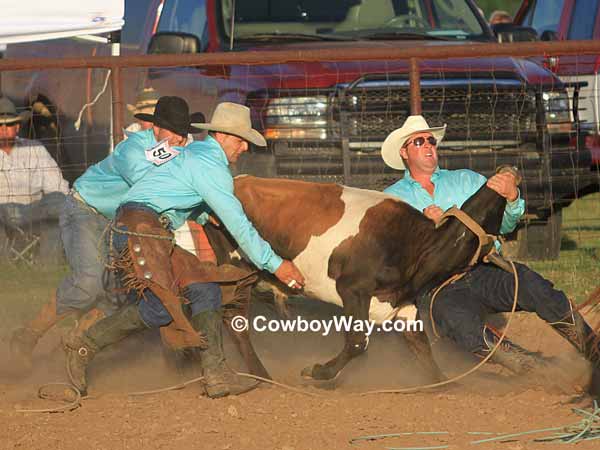
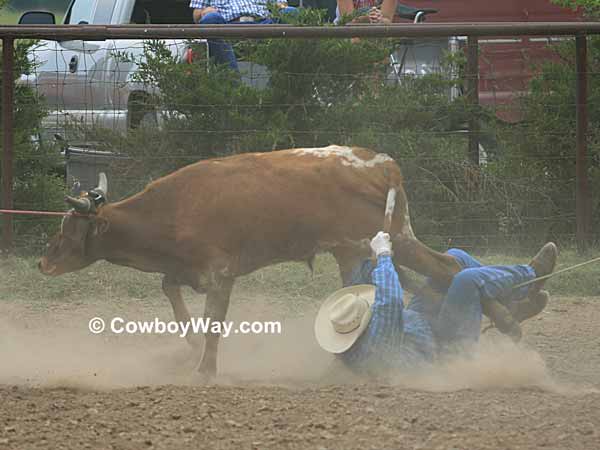
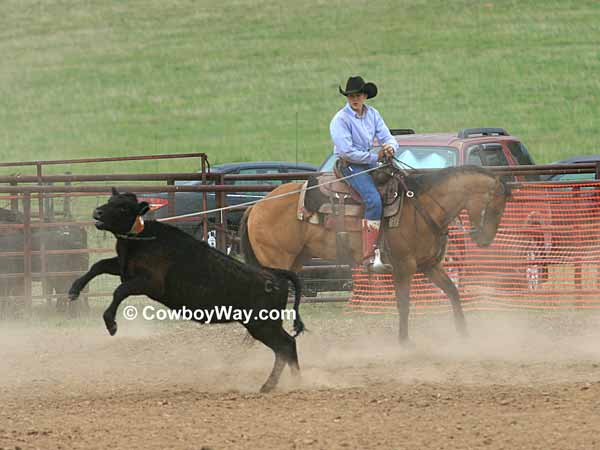
All photos are copyrighted © and property of CowboyWay.com
Ranch Rodeo Photos, Men's - Page 1
Ranch Rodeo Photos, Men's - Page 2
Ranch Rodeo Photos, Men's - Page 3
Ranch Rodeo Events
A ranch rodeo is a rodeo where contestants compete as teams from ranches, instead of as individuals as in a "regular" rodeo. While the number of team members can vary, 4 or 5 members per team is common. While ranch rodeo is competed in by men more commonly than women, women are sometimes members of a ranch rodeo team. There are also ranch rodeos just for women.
Below are generalized descriptions of some of the events typically round in a ranch rodeo, along with a brief mention of some of the rules. While the descriptions and rules provided below are common, they are for descriptive and general overview purposes only. The events, descriptions, and rules for a ranch rodeo you may compete in or watch could easily be different.
Ranch Bronc Riding Event
Ranch bronc riding is a "ride as ride can" event where a rider tries to stay on a bucking horse for a set time limit (8 seconds is common). The event is judged, usually by two judges, with the highest score determining the winner. Contestants ride the broncs with ranch saddles, as opposed to specialized "saddle bronc" saddles or "bareback riggings" seen in other types of rodeos. The ranch bronc riding event is unique in ranch rodeo for a couple of reasons: 1) It is the only event where one team member competes alone, 2) It is the only judged event. The ranch bronc riding event might be included as one of the events in the overall ranch rodeo, or it may be held as a stand-alone event where the competing individual is competing only for himself, and not as part of a team. You can find more information on ranch bronc riding on this page, underneath the photos.
Wild Cow Milking Event
Wild cow milking is a timed event that begins when a cow is turned loose into the arena. The team will try to rope the cow, "mug" her (control her by hand, particularly the head), and milk her until they get a small amount of milk in a bottle. The time usually stops after a time and/or loop limit has been reached, or when the cow has been milked and one member of the team runs with the bottle to a designated area in the arena. For the time to count, there has to be a certain amount of milk in the bottle. For example, in many wild cow milking events there must be enough milk in the bottle that at least one drop runs out when the bottle is turned upside down. The team that can rope, mug, and milk their cow with the fastest time wins. You can see wild cow milking pictures here.
Sorting Event
Sorting is a timed event that starts with a small group of cattle located at the end of the arena behind a chalk line. All or most of the cattle will be individually numbered (large, numbered collars are commonly used). As the first team member rides across the chalk line toward the cattle, the time starts and the announcer calls out a number. The team members must ride their horses to sort one head out of the herd at a time, beginning with the one called out by the announcer, and move it across the chalk line away from the rest of the herd. Once that animal has been sorted out the team members then sort out the next one, working in numerical order. How many head the team has to sort out in order varies: They may need to sort out 3 head, or 5, or some other number. If any cattle make their way across the chalk line out of numerical order, or if any of the cattle that have been sorted out returns to the herd, it usually results in a disqualification. Time stops when a time limit has been reached, or when the team has sorted all their cattle.
Branding Event
Branding is a timed event in which calves are roped and "branded." (The branding irons are not actually hot, but instead are dipped in chalk.) The branding begins with a small group of calves behind a chalk line in a corner of the arena. As one or more teams compete, the other teams will help to hold the calves behind the line. The competing team(s) will have one mounted team member (the roper), while the other team members are on foot (the ground crew). The roper ropes one calf at a time and brings it a short distance to the ground crew. What constitutes a legal catch for the roper can vary from one ranch rodeo to the next, but common legal catches include the head, by one heel, or by two heels. When the calf reaches the ground crew they must lay it on its side, remove the rope, retrieve the branding iron from a bucket, then "brand" the calf. There is often a two-calf limit, meaning each competing team only needs to rope two calves at the most. Time stops when a time limit has been reached, or when the last calf is roped and the branding iron is placed back into the bucket. Teams branding two calves will place over teams only branding one calf.
At some ranch rodeos larger cattle, such as yearlings, are roped and branded instead of calves. If this is the case, the larger cattle are usually turned into the arena one at a time to be roped, instead of roped out of a herd as with calves.
Mugging Event
The mugging event is a timed event in which a steer is roped and tied down by three legs. Time begins when a steer is released into the arena. The team members ride to the steer and one of them ropes it by the head. Typically, there are three legal head catches allowed: The loop going around both horns, around the neck, or a half-head (around one horn and under the neck). Next the team usually has the option of heeling the steer, or of laying the steer down without heeling it. After the steer is roped by the head and/or the heels, the team members that didn't rope will dismount and lay the steer on its side and tie three legs. Once the members on the ground have the steer under control the member(s) that roped will usually dismount and help them tie the steer. Time stops when a time and/or loop limit has been reached, or after the steer is tied down and a team member signals for time. Typically, the steer must remain tied for a few seconds (6 seconds is common) before the run is officially recognized.
Double Mugging Event
The double-mugging event is similar to the mugging event, except that two steers are released into the arena instead of one. This means that the team members divide up, with 2 members roping and mugging one steer while the other two members rope and mug the other steer. If 2 of the team members rope and mug their steer faster than the other two members, they are usually allowed to assist their team members once their own steer is roped and tied.
Doctoring Event
Doctoring is a timed event in which a steer is headed (roped around the head) and heeled (roped by the heels), then a chalk mark is placed on its head. The event begins when a steer is released into the arena. When the steer crosses a chalk line, or when a judge gives the signal, the time starts and the team members ride to the steer. One of the team members will rope the steer by the head. Typically, there are three legal head catches allowed: The loop going around both horns, around the neck, or a half-head (around one horn and under the neck). After the steer is headed another team member will rope it by the heels. As the two ropers hold the steer the remaining team members will dismount and mark the steer on its head with a piece of chalk. Time stops when a time and/or loop limit has been reached, or after the steer is marked and the team member signals for time.
Trailer Loading Event
Trailer loading is a timed event in which a steer is roped and loaded into a stock trailer. Time usually begins when a steer is released into the arena. The team members then ride to the steer and one of them ropes it by the head. If the roped steer moves toward the trailer while the roper is still mounted that's fine, but the rules usually strictly prohibit the roper dragging the steer with his horse. When the steer is as close to the trailer as the team can get him without dragging, they dismount, grab the rope and the steer by hand, and load it into the trailer. Depending on the rules, the team may or may not need to close a dividing gate inside the trailer and load a horse onto the back. Either way, after the back gate of the trailer is closed and latched the team runs a short distance to a designated area of the arena, usually a circle made with a chalk outline. When the last team member reaches the circle, the time stops.
